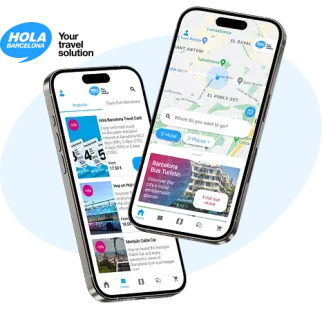El Born
The medieval streets where the avant-garde of Barcelona is found
El Born is the neighborhood that has changed the most historically, preserving its medieval charm and the bohemian air of the artists who settled there in the 20th century. In this medieval neighborhood of Barcelona, you will find a combination of eras: from Gothic palaces, museums, and churches to art galleries, restaurants, and innovative shops. El Born not only preserves part of the history of medieval Barcelona, mutilated by the War of Succession.

Barcelona Bus Turístic, on the Hola Barcelona app
Your app for visiting the city with the Barcelona Bus Turístic: routes, stops and the most iconic places. A comfortable way to carry your tickets too!
Walking through the streets of El Born, a must to understand Barcelona
The neighborhood, bounded by Paseo de Picasso and Calle de la Princesa to Calle del Rec, Paseo del Born, Santa María del Mar, Pla de Palau, and Avenida del Marqués de la Argentera, retains its small medieval Gothic palaces, although its narrow streets also hide the latest trends in art, fashion, and gastronomy.
During the last century, El Born became a kind of Montmartre, where artists like Picasso, Rusiñol, or Casas set up their workshops in the 20th century. Today, the area maintains a large number of art galleries and emblematic spaces that host new creators, as well as showrooms of new trends and gourmet shops.
Wandering aimlessly through its squares and streets will transport you to the medieval era of commercial splendor, when wealthy merchants filled Gothic palaces on streets like Montcada, where the Picasso Museum is located. Merchants coexisted with artisans, sailors, and guilds who built the basilica of Santa María del Mar, the best example of Catalan Gothic art. Many street names still reflect traditional medieval trades.
In the Fossar de les Moreres, a symbol of the city, a flame remains lit in memory of those who fell in the War of Succession of 1714, which mutilated the neighborhood. To learn about the history of that time, there is nothing better than visiting the Born Cultural Center, a former market, a jewel of iron architecture, where remains of part of the city destroyed in the war or demolished afterward to build the Citadel are preserved.
How to get to El Born?
With the Red Route of the Barcelona Bus Turístic, you will reach the Pla de Palau – Parc de la Ciutadella stop, from where you can explore the Born neighborhood.
For the curious
- El Born gets its name from the enclosure where medieval knights held tournaments and jousts, in the current Paseo del Born.
- Calle Santa María was full of small shops, highlighting the tailors La Lluna and El Vaixell, which disappeared at the end of the 20th century. The facade preserves a small metal boat that served as an advertising claim and recalls the existence of these shops.









